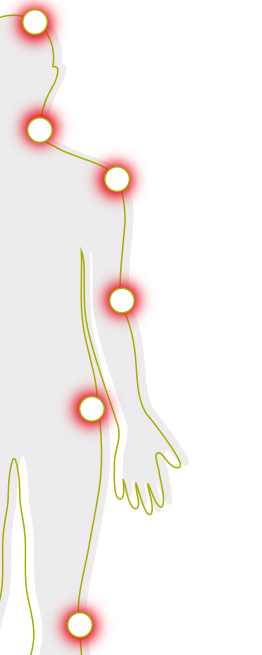Do you experience: teeth grinding, jaw-clicking?
Ringing in your ears? Discomfort in your head, neck or spine area?
And did you know that even headaches, sleep disturbances and tinnitus itself can be caused by the jaw? Are you perhaps one of those people who frequently suffer from one or several of these symptoms, but who have not yet received any specific diagnosis from your doctor or physiotherapist? Then you're not alone! A malfunction of the lower jaw and jaw joints (temporomandibular joint dysfunction or TMD) with a “bad bite” is frequently a result of a malregulation that can cause disorders throughout the body. If you are affected, ask a specialist who specialises in functional diagnostics (e.g. a dentist for functional diagnostics) about whether you might have a functional disorder.
Bad bites and TMD
Bite disorders and TMD with the symptoms described above are widely spread. These are functional disorders of the temporomandibular system (jaw, jaw joints, teeth, chewing structure). But causes can be both functional and structural, biochemical or psychological (e.g. teeth grinding due to stress).
The most important functions of the temporomandibular system are chewing and speaking: functions that we need all the time. If the patient has a functional disorder, chewing and speaking, and even laughing, can lead to persistent over-strain that can then cause stress symptoms that can be painful throughout the body.
A vicious cycle
If you have a functional disorder, your jaw’s stress-protection system, which is active during chewing, speaking and even laughing, notifies the brain that there is increased or a lack of contact between the teeth. The brain attempts to balance out the disorder using the chewing muscles. Those affected automatically bite down harder, putting unnatural strain on their jaws, teeth and muscles.
There can be an overlap between cause and effect. A bite disorder or TMD can be caused by years of teeth grinding due to stress – but it can also be reversed. The same applies to excessive strain if a dental prosthesis is not sitting correctly or in the case of old fillings.
Functional disorder?
Teeth speak for themselves: about 10% of the population is affected by misalignment of the jaw joints, including many headache patients. Up to 85% of headache patients suffer from a misaligned jaw and TMD, as an Essen-based neurologist claimed in the newspaper “Westdeutsche Allgemeine Zeitung” (Dr Gerhard in: WAZ, 2008). The teeth make contact with each other more than 1,500 times per day – about half of those at night – which means that it is not surprising that a bad bite and TMD can cause so many complaints. The high number of people affected means that we need to take action: get active for your own sake!
The dentist will help!
The causes of specific functional disorders should be analysed by your dentist. Manual-clinical and instrumental functional diagnostics are available for taking reliable medical histories and for therapy (e.g. in line with the DIR® Concept). This means that you as a patient receive really effective treatment!



